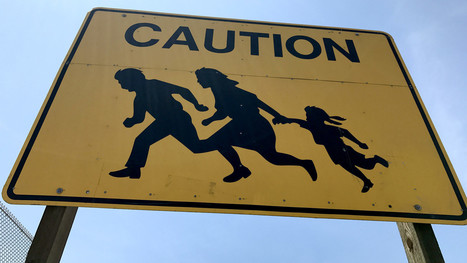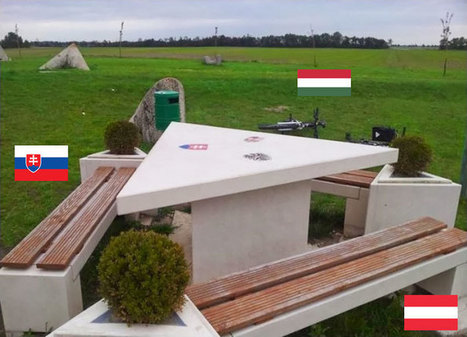Only one of the 10 iconic Caltrans caution signs emblazoned with the image of an immigrant father, mother and daughter running for their lives remains. They once dotted Interstate 5.
Get Started for FREE
Sign up with Facebook Sign up with X
I don't have a Facebook or a X account
 Your new post is loading... Your new post is loading...
 Your new post is loading... Your new post is loading...

Martin Kemp's curator insight,
December 17, 2015 3:45 PM
it seems that this a a recurring theme with china. disputed lands surround this country inside and out, they claim to own all of it as well. but when the people that live their claim to be independent and choose not to associate themselves with you than it creates and interesting dynamic. 
James Piccolino's curator insight,
March 24, 2018 9:52 AM
Very interesting. I am curious to know where this will lead to. There is something also unnerving about how most of us are never taught this in public schools even though it is a very big and very important topic. I can not image there being a split eventually over time, though there is no way that this area will stay as they are with the treatment of their government. This is surely a region to keep an eye on.
othni lindor's curator insight,
October 20, 2018 4:06 AM
This article talks about how the "government of the People’s Republic of China calls the country’s westernmost region Xinjiang, but the people who have lived there for centuries refer to their home as Eastern Turkistan." Usually when two groups or more have different names for the same place there is a political or cultural conflict happening in that country.
Kendra King's curator insight,
April 3, 2015 7:37 PM
This art seems like a logical extension of the government’s use of power although I personally don’t agree with their abuse of power. In China the government will uses its authority to monitor the personal activities of its citizens as demonstrated by the pictures dictating what people should and shouldn’t wear. When the citizens don’t follow through with China’s rule, violence typically happens. In fact, a fair deal of the paintings showed violence (i.e. the tank running people over). I actually find those depictions more offensive and disturbing than any of the other pictures because the end result is clearly that of dath rather than disapproval. Now, I understand that some places need to be ruled with an iron fist (i.e. Iraq), however I don’t really see how threatening people with more violence solves the issue of extremism. If anything, doesn’t this just give the extremist more of a reason to dislike the government? As such, is the government just creating more resentment that will lead to demonstrations in the future? I say this because eventually when a local population is subject to such horrible treatment, there isn't much else to lose and very little reason no to fight back.
Tanya Townsend's curator insight,
November 16, 2015 9:20 PM
This article has great insight on the way government influences popular belief. We have seen these many times in American society also when government was afraid of communism during the cold war for instance. Often we have prejudgements or beliefs and we are not sure where they even stem from. Pushed Propaganda can be very influential over the mass population, in instilling certain beliefs.
Adam Deneault's curator insight,
December 14, 2015 8:45 PM
The point the Chinese are trying to make is that the Muslim people are bad, they do unacceptable things and it needs to be taken care of. They are making it hard for a couple to get married and if they do it is with special permission. They even banned anyone under the age of 18 to enter a mosque. Praying in Xinjiang is highly regulated and comes with strict rules and consequences. In all their propaganda you can see how they represent getting rid of the muslims because they are wearing black. If you ask me, it seems like the government is doing this because they are afraid of being taken over and losing the area, just like we used to use propaganda in the wars.

Bob Beaven's curator insight,
March 19, 2015 12:46 PM
Most people often forget that the Silk Road passed into Central Asia and the Middle East from East Asia. This means that along the road, travelers often put things that reminded them of home. The Buddha statues that once existed in Afghanistan are an example of this. They were in fact labeled a world heritage site. Sadly, the Buddhas had been ravaged throughout history by radical arabs. This is because their religion frowns upon (actually forbids) idols, which they considered the statues to be. Although they had been tempered with for many years, the Taliban finally decided to blow them up in 2001. Now, there are differing opinions across various countries as to whether they should be rebuild or not. Afghanistan believes that they should be rebuilt so the government can claim a symbolic victory over the Taliban. Unesco wants a restoration done right, so for now it won't allow rebuilding to occur. Germans tried to rebuild them, but Unesco blocked it from happening. South Korea, Italy and Japan are all willing to donate money, but have no mention of the statues. I believe that the statues should be rebuilt, as the article points out monuments were rebuilt in France after Protestants burnt down many old Gothic Cathedrals. I also believe it is necessary because we cannot let the culture of hate that the Taliban believes in to win. Average Muslims realize that the statues have historical significance and that they do not need to worship Buddha to respect that this site was 1,500 years old. I also think it would send a strong message from the Afghan government if the statues were rebuilt because it would show they, like the article states, are not going to let the Taliban rule their country.

Kristin Mandsager San Bento's curator insight,
April 7, 2015 9:42 PM
I find it interesting that other countries are divided. Why are they deciding the future for this country? They can't seem to get out of their ways to come up with a real solution. Its unfortunate.
Benjamin Jackson's curator insight,
December 14, 2015 11:40 AM
this is a reminder of what extremism can do to ancient works of art that they view as heretical. these ancient, massive statues were carved out of living rock by ancient Buddhists, and had withstood the test of time until Afghan terrorists blew them up. |
Mark Hathaway's curator insight,
October 30, 2015 6:50 AM
The removal of an historical statue, is a broader reflection of what the population of a particular place is thinking. Who a people choose to honor, is a statement of the ideals they hope to espier to. For many people in South Africa, Cecil Rhodes is a symbol of racist colonial tendencies. You can not separate Rhodes from the age of western imperialism. He was one of the leading figures in the scramble for Africa in the late 19th century. In the United States we have seen a similar push to remove statues of historical figures with connections to slavery and racism. Many have called for the removal of statues honoring confederate leaders such as Jefferson Davis or Robert E Lee. The push has even spread to figures beyond those directly connected to the confederacy. The democratic party has removed the names of Thomas Jefferson and Andrew Jackson from there annual party dinners. There connections with slavery and Native American treatment are just too much for some outraged democrats to handle. I am uneasy about the removals of these statues. History can never be erased. It is futile, to even attempt to do such a thing. Historical figures should be judged by the context of the times in which they lived. It is unfair to judge Thomas Jefferson by the standards of our modern age society. The overt political correctness is troubling to say the least. It is a whitewash of history. |


















